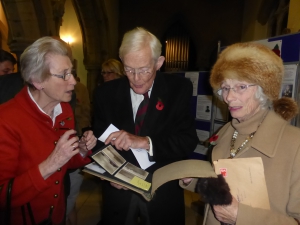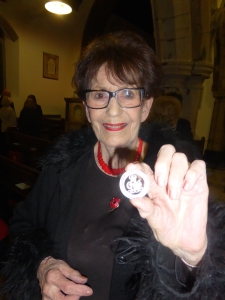Holme Pierrepont WW1 Centenary
Holme Pierrepont, is a small Nottinghamshire village adjacent to the much larger village of Radcliffe on Trent. It is dominated by Holme Pierrepont Hall where the Pierrepont family has lived since 1280. Charles Pierrepont became the 1st Earl Manvers in 1773 and the title continued until the death of the 5th Earl in 1940. Next to the Hall stands the Grade 1 listed Parish Church of St Edmunds.
A survey of the Manvers Estate in 1900 shows it owned properties, dwellings, farms and 1,000 acres of land in the parish of Radcliffe on Trent and, despite disposal sales in the following years, the Estate still owned several farms, 571 acres of land and numerous properties in Radcliffe before World War 1.
Landowner Charles William Sydney Pierrepont became the 4th Earl Manvers in January 1900. Living at Holme Pierrepont Hall in the run up to the war, he knew the area well, serving regularly on the Bingham bench of magistrates, becoming the first chairman of Radcliffe on Trent Parish Council in 1894, elected as Conservative M.P. for the Newark division of Nottinghamshire between 1885 and 1895 and Master of the Rufford Hunt from 1900. He had a background in the military having been Captain of the Nottinghamshire Yeomanry, honorary Colonel of the 8th Battalion Sherwood Foresters and Brigadier General of the Staffordshire Regiment. When WWI broke out, Holme Pierrepont men gravitated towards his former regiments. Several were tenants of the Manvers Estate, like many of those from Radcliffe who served their country.
Commemorating WWI
Residents of Holme Pierrepont wanted to be part of the national WWI centenary celebrations. They decided to invite descendants of those on their memorial to a special Remembrance Service in November 2014 and brought in researchers from the Radcliffe WWI project to help find them. Unlike neighbouring Radcliffe on Trent, there is no formal memorial inside the church grounds. Instead, the memorial at St Edmunds Church is a Grade ll listed lychgate erected in 1921 and listed in 1986. On each of the rock-face ashlar walls is a memorial plaque – the one on the left commemorates the names of five men who did not return and, unusually, the plaque on the right lists the names of fifteen who did return. The inscriptions read In memory of those who gave their lives in the cause of freedom, 1914-1919 and Remembering with thanksgiving those who answered the call of their country and by the grace of God returned.
Searching for relatives
The search began in 2014 when Cynthia Stacey, secretary to St Edmunds PCC, told me about her desire to find relatives of those named on the memorial. Having an interest in local history I offered to help – after all there were only twenty names from eleven families and we were going back only a hundred years. When we went through the names together, we already knew relatives of four families whom we’d be able to contact. The lack of census returns after 1911 and the absence of rental returns for the period 1861 – 1935 for the Holme Pierrepont Estate made the search difficult. However, we had a positive response to our appeals on the local West Bridgford Wire website and in the Nottingham Post for descendants to come forward. There were seven sets of brothers on the memorial, representing sixteen names. Of these, we succeeded in contacting relatives of eleven men from five families. We were able to contact one further family from the remaining names.
Researching names on the memorial plaques
What began as an exercise to find relatives developed into a project looking at the history of Holme Pierrepont’s memorial and researching local men who served their country. .A member of the Radcliffe on Trent WWI team brought her experience of researching military records to the project and together we created a profile sheet listing key facts that needed to be found for the Holme Pierrepont servicemen such as date and place of birth, names of parents and siblings, census details, military unit, service number, rank and so on. We knew there was a crossover between the two villages through marriages and employment patterns and we began to link the two places.
We researched men’s histories by studying census returns, family history websites, the British Newspaper Archives, St Edmunds Church register of marriages and the survey of graves at St Edmunds Churchyard conducted by Radcliffe on Trent Local History Society. From the 1918 Absent Voters List we identified two local men in the military who are not listed on the plaques.
We wrote biographies for the twenty two men describing their military service, details of their lives in Holme Pierrepont and, where relevant, connections with Radcliffe on Trent. Two marriages with Radcliffe women were noted. Eight men were confirmed as being officers and fourteen as ‘other ranks’. Their gallantry awards included two military medals and one mention in despatches. Of the brothers, two served in the RAF, two in the yeomanry and two with the 2/8th Sherwood Foresters. Five men were in the artillery. Other military units included the Machine Gun Corps, East Lancashire, Manchester and South Staffordshire Regiments, Royal Army Service Corps and Royal Army Vetinary Corps. Two men became prisoners of war, one of whom died in captivity. Looking at the other four deaths, two men were killed at the Battle of the Somme, one at the 3rd Battle of Ypres and one in an accident in England.
In common they all lived in or had a connection with the parish of Holme Pierrepont and Gamston, but came from different walks of life. On the one hand, there were the sons of the vicar of St Edmunds, sons of a solicitor and a son of a lace manufacturer. On the other hand, there were sons of tenant farmers, farm labourers and Earl Manvers’ groom. We found fame with Henry Cursham, father of serving sons, who remains the record holder for the most goals scored in the history of the FA Cup. Another father, the Rev. W. Saward was a famous playwright. As expected there was sadness in several stories; for some it came years after the war had ended.
The Service of Remembering, Commemorating and Honouring
The service took place at St Edmunds Parish Church on Sunday, 9th November 2014 at 6.30 pm. It was conducted by the Revd Canon Howard Bateson.
The congregation made its way along an unlit and unmade road towards the bright lights and warmth of St Edmunds Church to the sound of ringing bells, just as those on the war memorial would have done when attending Evensong a century earlier.
The service began with the processional hymn followed by the Revd Canon Howard Bateson’s welcome, introduction and the congregation joining the choir in singing ‘O Valiant Heroes’. Cynthia Stacey, Diana Barrett and Diane Kidger read out the names on the war memorial. Their voices echoing in the utter silence in the Church was a profound and emotional moment in the service.
When the Last Post was sounded, flags were lowered inside the church. The dignitaries each laid their wreaths on the altar steps. The ceremony was followed by the Reveille. There were further hymns and prayers and the Revd Canon Bateson gave his sermon. The service ended with the National Anthem and the blessing. The choir and vicar left the nave to the singing of the Recessional Hymn.
Afterwards, coffee and biscuits were served in the Church and the congregation was able to meet the relatives and view the exhibition. We were delighted the following descendants, with accompanying families and friends, attended the service.
The daughter of Harold Checkley Cresswell, who was also the granddaughter of George Robert Cresswell
The son of Curzon Cursham
The niece of Job Willatt and William Willatt
The daughter in law of Eric Henry Pell, related by marriage to Joseph William Pell and Harold Whitt Pell and the great niece of John William Brewitt and Joseph William Brewitt.
Unfortunately, the relatives of Curtis Machin were unable to be present.
The local dignitaries attending the service and laying poppy wreathes were:
Cllr Angela Dickinson representing Rushcliffe Borough Council,
Cllr Kay Cutts, ward member for Notts. County Council,
Cllr Jonathan Wheeler, ward member for Rushcliffe Borough Council,
Cllr Melvyn Tisbury, chairman of Holme Pierrepont and Gamston Parish Council
A Representative from the British Legion.
We exhibited profiles of each man on the war memorial and of the two men we found on the Absent Voters List, together with a map of the parish indicating where the families lived at the time of the 1910 Finance Act. The Church and display were decorated with imaginative poppy flower arrangements created by Cynthia Stacey. After the service, the wreaths were hung from the lychgate. The exhibition can still be viewed in the church.
Note on the 1910 Finance Act
- The principle levy of the 1910 Finance Act was increment value duty, which was levied at the rate of 20% on any increase in the site value of land between an initial evaluation carried out on 30th April 1909 and the occasion of its sale or other transfer. In order to obtain the base rate from which the increase in the value of the land would be worked out, the act provided for a valuation to be made of all the land of the United Kingdom between 1910 and 1920, and it is this valuation that has provided us with the wealth of information about land and property at the time. The information gained from these forms was transcribed into valuation books or doomsday books, and also into the valuers’ field books. An inspection of the property was then made, where the valuers added additional detail about the property into the field books. It is these books therefore that give the most detailed information about the properties surveyed. The Valuation Office usually used the most recent Ordnance Survey and largest scale Ordnance Survey map available.
Author: Diane Kidger









